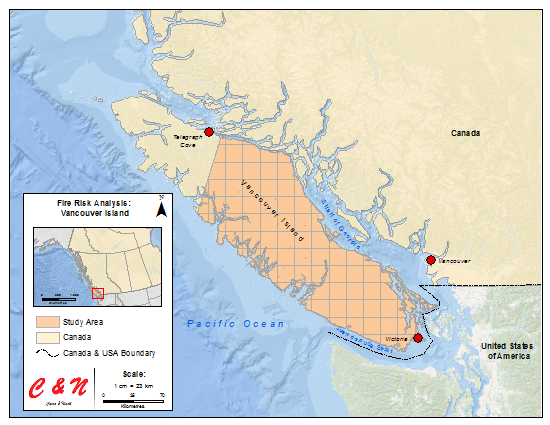Fire Risk Analysis using QGIS
NOTE: This is a work in progress, and subject to change.
Purpose
This tutorial will demonstrate how to use multiple tools within QGIS in order to run a fire risk analysis, manipulating vector and raster data, along with the final output of maps. This tutorial uses tools from QGIS' advanced interface, which include QGIS, GRASS GIS, and plugins that you will need internet connection for in order to download them into QGIS. Major tools that will be used in this tutorial include:
Build Virtual Raster Catalog - QGIS, Clipper - QGIS, Merge Vector Layers - QGIS, Raster Calculator - QGIS,
Aspect and Slope - GRASS GIS, Reclass - GRASS GIS,
Heatmap - Plugin, along with other tools.
It is recommended that you have some knowledge of a GIS before attempting this analysis, this is an advanced tutorial.
Introduction
For the purpose of this tutorial, the study area that will be used to demonstrate a Fire Risk Analysis will be approximately 75% of Vancouver Island from just South of Telegraph Cove to Victoria (Figure 1). During this fiscal year (April 1, 2015 – March 31, 2016) there have been 1 843 fires in the entire province of British Columbia which has resulted in approximately 305 000 hectares of land being burn. The area that we will be analyzing for the purpose of this tutorial around Vancouver Island has had just under 200 fires resulting in approximately 25 000 hectares of burnt land according to the Government of B.C. Wildfire Service.
This tutorial will show how to create maps that identify areas that have a high risk of fires based on multiple factors. These maps in turn, can help responders react quicker to help prevent future fires by implementing measures based on the high risk of fires in a certain area on the island.
All data and software used in this tutorial are open-sourced and can be found online.
Figure 1: The study area for this tutorial is shown here as a pink grid feature, from just south of Telegraph Cover to Victoria.
Software
Data
In order for the analysis to be run, data sets were identified through based upon research of academic journals and research papers that topics included a fire risk analysis, assessment or use of a GIS with forest fires. Based upon the research, the 5 major data sets that were needed include:
1. Census subdivisions & attribute data (population density)
2. Landsat 8 imagery (Normalized Difference Vegetation Index - NDVI)
3. Elevation model - (aspect and slope = DEM)
4. Past wildfires (spatial pattern/clustering)
5. Mitigation factors (bodies of water)
The data sets were then categorized into three different categories (Table 1), which will create three maps that will be calculated against each other; fire hazards, vulnerability factors & mitigation factors.
Table 1. Data sets that were collected, categorized into three different categories.
Links to data sets used;
1. Census Subdivisions Attribute Data Attribute Data *
2.
* Must be a Carleton University alumni, faculty, student or other institution approved by CHASS in order to access this attribute data.
